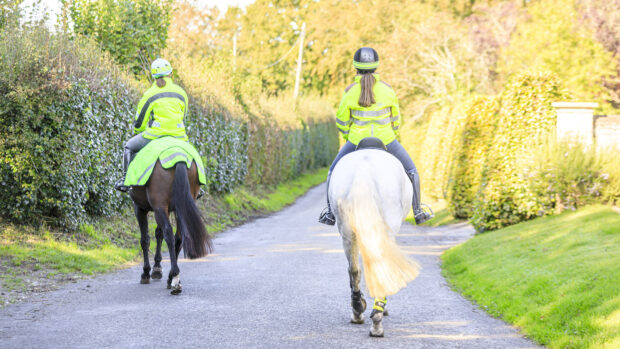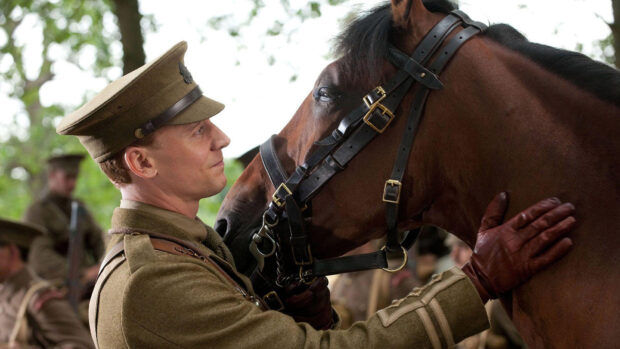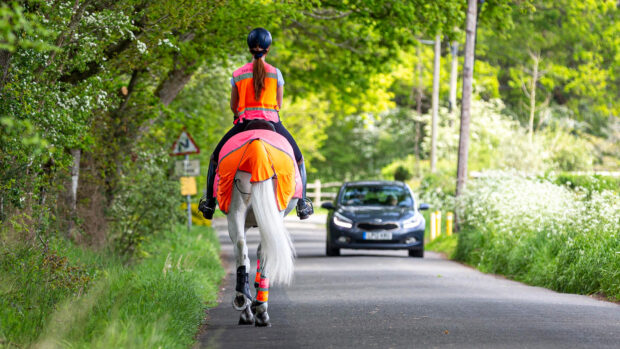Several Army horses were in the spotlight last month when falling rubble at a London building site caused them to spook and unseat their riders. The story shone a light on how even well-trained horses can be upset by unexpected situations – but have the loose cavalry horses improved road safety?
On 24 April, five Household Cavalry horses broke away from their group exercise in Belgravia, near Buckingham Palace. Four soldiers fell – three were assessed in hospital with non-life threatening injuries – but the most startling detail of this widely-reported story was the five-mile charge of two bloodied horses through the nation’s capital.
Distressing images of Quaker, a Cavalry black, and Vida, a grey, were plastered on front pages the following morning (25 April) and many news outlets operated live coverage on their websites. Opinion columns on the story appeared in the days that followed as equestrians and non-equestrians alike clamoured to know what was to become of the pair – who underwent surgery shortly after being caught on the other side of London.
Subsequent updates issued by the Army suggest Vida and Quaker are making progress and are being observed closely as their wounds heal. Reports from the Army reveal Quaker is expected to make a full recovery. However, according to some riders, this story’s impact has been significant, with some noticing changes for the better in the conduct of motorists.
Loose Cavalry horses: “It’s brought it home to drivers”
When Louise Meadows, 58, hacked out with her 27-year-old Connemara cross, Mystery, last Saturday (27 April), she noticed drivers passing her with a more courtesy than usual. When she posted her experience in the Pass Wide and Slow Facebook group, linking it to the events in London earlier that week, several other riders concurred.
The group, which has over 50,000 members, was established to try to educate drivers on how to pass horses safely, while also supporting riders. It encourages members to organise awareness rides to help educate motorists on passing horses safely. The group also advises equestrians to wear hi viz for horses and hi viz for riders, although that is not its primary function.
Louise, who is based north of Peterborough, says: “It’s mainly roadwork where we are, unless we hack for a decent amount of time to get to a bridleway.
“I ride on the road all the time. My horse wears leg bands, I’m in a hi-vis jacket and hat band, so no one can say they can’t see us. Drivers are in a rush, and don’t have time for us horse riders.”
Recalling her hack with a friend on Saturday, Louise says drivers seemed to be a lot more courteous.
“We went on a road we don’t go on all the time – it’s a back road that’s notorious for people using it as a cut through.
“Often people misinterpret our hand signals to them to stop or slow down and just wave back, or ignore it completely, but they seemed to listen this time. We always say thank you, but rarely get a thank you back. This time, people were more respectful.”
Louise attributes some of the caution showed by motorists to the fact Mystery is grey.
“That poor grey horse was covered in blood, I think that really brought it home to people.”
“When they saw the pictures of the smashed bus windscreen and the taxi dented, that probably made them think ‘that could be me and my family’.”
Louise says Mystery is more likely to spook at “a dark patch of grass” than a car, but other road users don’t realise this.
“They say when horses jump to the side it can be a quick as 40mph, people don’t realise how quickly they react. If we preempt something they might look at, we put a hand up to tell [the motorist] to stop. We’re trying to keep everyone safe, some riders are children, but they don’t always adhere to it.”
Louise said the root of the problem is lack of patience.
“It takes half a minute or less to get past safely and it makes all the difference.”
“Some people had increased awareness”
Leanne Docherty of Denbighshire, North Wales, noticed drivers “slamming on [their brakes] a bit” the day after the incident in London.
She and her eight-year-old Andalusian/Welsh Section D, Taran, spent a lot of time walking their local hacking routes in-hand as part of Taran’s backing as a youngster.
“Because of this, he is good in traffic,” says Leanne. “Even so, I am aware that all it takes is a plastic bag or a pheasant to fly out of a hedge, or a fast oncoming car, and it could be game over.”
Leanne described her local hacking as “monotonous, if you’re not prepared to venture on to or across the road.”
“Drivers on the whole are quite considerate on the back lanes,” she continues. “On the main roads however I do feel that driver see you and think ‘well, you’re taking the chance bringing your horse on this road, why should I be inconvenienced?’”
“I rode my horse the day after the incident with the cavalry horses and did think that some drivers had increased awareness of the need to be slow and safe around horses. Then, I got to the main road where I needed to walk 150 yards to get to a quiet back lane on the other side.
“None of the drivers on this road slowed down and it still felt like there was absolutely zero regard for their responsibility, as well as my own, to make sure we pass each other safely.”

Leanne (pictured) says hand walking Taran on the roads before backing has made him reliable with vehicles.
Leanne was “horrified” to see the pictures of cavalry horses Vida and Quaker.
“I must admit my first thoughts were ‘great, the horses don’t belong on roads crew have just got more fodder’. We equestrians know that a horse has the ability to respond in flight regardless of training – but the non-equestrian public I feel will use this as an argument that horses do not belong on the road.”
“I hope it continues”
Athene Jordan, 52, and her partner live in Whitley Bay in the North East with their two horses Ollie (23) and Ted (15). Athene and her partner always ride in hi viz, and make use of a riding hat camera.

Techalogic D2 Pro | AmazonThis camera records in front of and behind you and has a long battery life, so is great for hacking.
She says the couple has noticed a “massive change” in the actions of other road users.
“The farm where we keep our horses is based on a major A road, which we have to cross every time we go hacking,” she told H&H.
“Since the incident, we have noticed a massive change in drivers’ attitudes, immediately after. A lot of vehicles are giving us a much wider berth and slowing down more.
“I think it has given some drivers a wake-up call, showing how quickly horses can respond. I hope this continues, and people don’t forget what happened too quickly.”
Do you think the incident with the cavalry horses has improved road safety in your area? Email us your thoughts at hhletters@futurenet.com
You may also be interested in…

Police ‘risked their own safety’ to help injured Army horses loose on the streets of London

More than one horse still dies on British roads every week

The Household Cavalry: its history, the regiments and the famous Cavalry Black horses

Double-decker stables and a hidden horse walker: is this Britain’s most compact yard?

Subscribe to Horse & Hound magazine today – and enjoy unlimited website access all year round
Horse & Hound magazine, out every Thursday, is packed with all the latest news and reports, as well as interviews, specials, nostalgia, vet and training advice. Find how you can enjoy the magazine delivered to your door every week, plus options to upgrade your subscription to access our online service that brings you breaking news and reports as well as other benefits.




